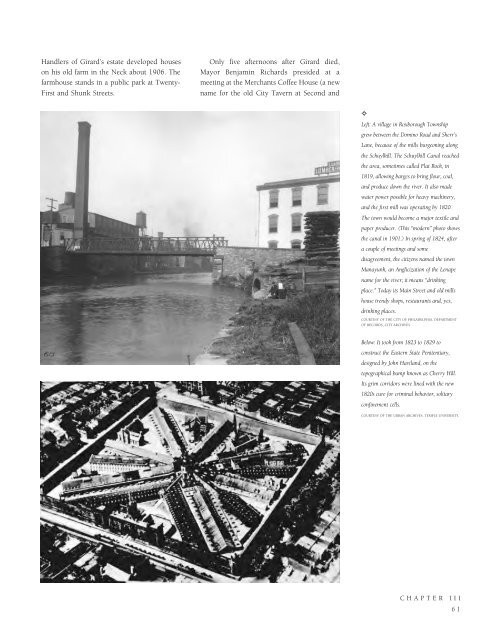Historic Philadelphia
An illustrated history of the city of Philadelphia, paired with the histories of companies, families and organizations that make the region great.
An illustrated history of the city of Philadelphia, paired with the histories of companies, families and organizations that make the region great.
Create successful ePaper yourself
Turn your PDF publications into a flip-book with our unique Google optimized e-Paper software.
Handlers of Girard’s estate developed houses<br />
on his old farm in the Neck about 1906. The<br />
farmhouse stands in a public park at Twenty-<br />
First and Shunk Streets.<br />
Only five afternoons after Girard died,<br />
Mayor Benjamin Richards presided at a<br />
meeting at the Merchants Coffee House (a new<br />
name for the old City Tavern at Second and<br />
✧<br />
Left: A village in Roxborough Township<br />
grew between the Domino Road and Sherr’s<br />
Lane, because of the mills burgeoning along<br />
the Schuylkill. The Schuylkill Canal reached<br />
the area, sometimes called Flat Rock, in<br />
1819, allowing barges to bring flour, coal,<br />
and produce down the river. It also made<br />
water power possible for heavy machinery,<br />
and the first mill was operating by 1820.<br />
The town would become a major textile and<br />
paper producer. (This “modern” photo shows<br />
the canal in 1901.) In spring of 1824, after<br />
a couple of meetings and some<br />
disagreement, the citizens named the town<br />
Manayunk, an Anglicization of the Lenape<br />
name for the river; it means “drinking<br />
place.” Today its Main Street and old mills<br />
house trendy shops, restaurants and, yes,<br />
drinking places.<br />
COURTESY OF THE CITY OF PHILADELPHIA, DEPARTMENT<br />
OF RECORDS, CITY ARCHIVES.<br />
Below: It took from 1823 to 1829 to<br />
construct the Eastern State Penitentiary,<br />
designed by John Haviland, on the<br />
topographical bump known as Cherry Hill.<br />
Its grim corridors were lined with the new<br />
1820s cure for criminal behavior, solitary<br />
confinement cells.<br />
COURTESY OF THE URBAN ARCHIVES, TEMPLE UNIVERSITY.<br />
CHAPTER III<br />
61
















